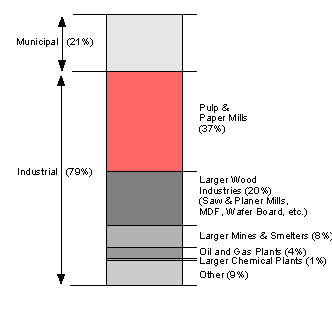Some Uses of Genetic Engineering to Modify Wood Composition in Trees
Figure 8 Waste Management Fees 2000
Click thumbnail to view full-size
Manipulation of Lignin
Lignin biosynthesis is a very complex process which has been mapped out. However the details of the pathway have still not been discovered yet (Lybeer, 2006).
Less Lignin
If plants had less lignin, they would break down more rapidly. This would mean that less energy and time would be required to process plants into pulp at paper mills. This means that paper and pulp mills would produce less pollution, since they usually need harsh chemicals to dissolve the lignin which gets mixed with the water used to wash it off, resulting in water contamination [Figure eight]. This pollution has negative effects for organisms living in the surrounding areas. For example, organochlorines are produced, which include dioxins that accumulate in organisms, causing cancer and birth defects. They also have negative effects for humans because both the mills and residentials would find it preferable to be placed next to bodies of water.
It is also thought that if plants produce less lignin, they will produce more ethanol. This is because if cellulose is enclosed in lignin, it is difficult for enzymes to reach the cellulose and break it down into simple sugars that can be converted to ethanol (Pollack, 2007).
More Lignin
If plants had more lignin, they would be much stronger (Lybeer, 2006). This would be advantageous since they would make more sturdy building materials. The Forestry Commission (2012) advises “Using wood as a building material is climate-friendly and sustainable”. Also, some crops are fragile because they are top heavy e.g. often wheat is destroyed after a late summer rainfall or strong winds.
Plants would also be better protected because the lignin would act as a ‘shield’ against insects, disease, bacteria and fungi (Lybeer, 2006). Normally, for example, stem-boreing insects are able to get through the stem and the hyphae of fungi can grow into weak stems, thus harming the plant.
Faster Growing Trees
The gene from the fast-growing Arabidopsis weed was altered so that the plant cell wall structure stimulates growth and scientists have put it into eucalyptus trees. FutraGene say that the trees can grow 5 metres a year, with 20%-30% more mass than a normal eucalyptus (Vidal, 2012).This means these trees would be able to produce large quantities of wood fibre in a comparatively short time, which helps to reduce the pressure for natural woodlands (Cossalter et al, 2003).
Use for Fuel
These faster growing trees could be used for fuel. Boerjan (2010), said “The yield of bio-ethanol from the wood of GM poplar trees from a VIB field trial is up to 81% higher than non-modified poplars.” The advantage of having this quick growing fuel is that it would be carbon neutral, and so would not contribute to global warming, and a renewable energy type.
Thus, it would be far less damaging than current sources of energy e.g. burning fossil fuels (Pauly et al., 2007).
Use for Manufacturing
They could also be used for the manufacture of paper, cotton and other products. This is because for each tree which is planted, more cellulose would be produced to either get reduced to a pulp, washed, bleached, dried, pressed and smoothed to make paper or for the fibres to be woven to make cotton (Strnad, 2000). Thus, more products could be manufactured per tree, therefore needing fewer trees to be cut down and increasing efficiency.
References
Alberts, B. et al. (2002), Molecular Biology of the Cell [4th edition], Garland Science.
Boerjan, W. (2010), ‘Initial Field Test Results GM Poplars: Bioethanol Yield Almost Doubled’ [online journal], Available at http://www.vib.be/en/news/Pages/Initial-field-test-results-GM-poplars-bioethanol-yield-almost-doubled.aspx, (Accessed: 24/11/12).
Cossalter, C. et al. (2003), Fast-Wood Forestry: Myths and Realities, Indonesia Printer, Available at http://www.cifor.org/publications/pdf_files/Books/ForestPerspective.pdf, (Accessed: 24/11/12).
‘Frontier in Plant Physiology’ (page 1) [online journal], Available at http://www.frontiersin.org/Plant_Physiology/10.3389/fpls.2012.00085/abstract, (Accessed: 24/11/12).
Guardian, ‘The GM Tree Plantation Bred to Satisfy the World’s Energy Needs’, Available at http://environment/2012/nov/15/gm-trees-bred-world-energy, (Accessed: 24/11/12).
Lybeer, B. (2006), ‘Lignification and Cell Wall Thickening in Nodes of Phyllostachys viridiglaucescens and Phyllostachys nigra’, Annuals of Botany, Volume 97 (pages 529-539), [online journal], Available at http://aob.oxfordjournals.org/content/97/4/529.full.pdf, (Accessed: 20/11/12).
Matthews, C. et al. (1999), Biochemistry, [3rd edition], Benjamin Cummings.
Meike (2012), ‘Inexpensive, Environmentally Friendly and High Permeable Lignin-Based Ion Exchangers’, Industrial Partnership Office, Available at https://ipo.llnl.gov/?q=technologies-lignin_based_ion_exchangers, (Accessed: 24/11/12).
Pauly et al. (2007), ‘Cell Wall Carbohydrates and their Modification as a Resource
for Biofuels’, The Plant Journal, Volume 54 (page 1) [online journal], Available at http://public.wsu.edu/~lange-m/Documnets/Teaching2011/Pauly2008.pdf, (Accessed: 24/11/12).
Pollack, A. (2007), ‘Through Genetics, Tapping a Tree’s Potential as a Source of Energy’, The New York Times, Available at http://www.nytimes.com/2007/11/20/science/20tree.html?pagewanted=all, (Accessed: 24/11/12).
Scheller H., Ulvskov, P. (2010), ‘Hemicelluloses, Annual Review of Plant Biology’, Volume 61 (page 1), [online journal], Available at http://www.annualreviews.org/doi/abs/10.1146/annurev-arplant-042809-112315, (Accessed: 22/11/12).
Strnad (2000), ‘Cellulose Fibres Functionalised by Chitosan: Characterization and Application’ [online journal], Available at http://cdn.intechopen.com/pdfs/12146/InTech-Cellulose_fibres_funcionalised_by_chitosan_characterization_and_application.pdf, (Accessed: 24/11/12).
The Forestry Commission (2012), ‘Replace Other Materials with Wood’, Available at http://www.forestry.gov.uk/forestry/INFD-7M8MXV, (Accessed: 22/11/12).
Underwood, W. (2012), The Plant Cell Wall: A Dynamic Barrier Against Pathogen Invasion, UXL Encyclopaedia of Science (2002), (Second edition), The Gale Group Inc.
Vidal, J. (2012), The GM Tree Plantations Bred to Satisfy the World's Energy Needs.
Zaikov, G. et al. (2004), Polymer Analysis, Degradation and Stabilization (Pages 97-100), Nova Science Publishers Inc.









